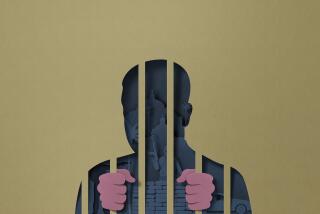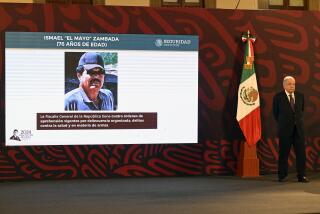U.S. Aiding Hunt for Peru’s Ex-Spymaster
- Share via
LIMA, Peru — As Peruvian investigators step up their international manhunt for fugitive spy chief Vladimiro Montesinos, U.S. law enforcement officials have taken a prominent role in efforts to bring him to justice.
In addition to aiding the Peruvian operation, the FBI has opened two investigations of alleged violations of U.S. law linked to the former spymaster, who is believed to be hiding in Venezuela.
The cases involve alleged gun smuggling to Colombian guerrillas and money laundering in the United States, according to recent interviews with an FBI agent and other U.S officials. The spy chief’s mob-like network allegedly raked in hundreds of millions of dollars from drug trafficking, kickbacks related to military purchases and other crimes, Peruvian investigators say.
Last month, a task force of two U.S. federal prosecutors, five FBI agents and a Miami sheriff’s detective spent a week in Lima, Peru’s capital, working with a Peruvian special prosecutor and congressional investigators.
“This kind of visit doesn’t happen that often,” U.S. Ambassador John Hamilton said. “There is a very good level of mutual confidence with the special prosecutor and the congressional commissions. This recent visit kicked it up to another level.”
U.S. law enforcement has put considerable resources into the cumbersome task of building a case against Montesinos and his allies for both practical and political reasons.
The expertise of U.S. prosecutors and federal agents is valuable in confronting the worst corruption crisis in Peru’s history. The superheated environment and the multiple, sometimes overlapping investigations by the courts and Congress generate scandals and suspects on an almost daily basis.
“This was a very complex organization that had tentacles throughout the government,” said an FBI agent involved in the investigation. “It was like a racketeering enterprise.”
The complexity of the prosecutions would be overwhelming for the justice systems of most nations; Peru is in the midst of rebuilding democracy.
On the diplomatic front, cooperation by U.S. officials helps blunt criticism here that Montesinos’ longtime alliance with U.S. security forces, especially the CIA, helped him consolidate dictatorial powers during the regime of former President Alberto Fujimori.
A Continuing Danger
While most Peruvians are preoccupied with the current presidential campaign, the prosecution of the former chief of the National Intelligence Service, or SIN, remains a top priority of the transition government. Peruvian leaders want to capture Montesinos because of the scale of the alleged thievery--documented by numerous SIN videotapes--and because the remnants of his organization pose a danger at a moment of political uncertainty.
Moreover, there are fears that time is growing short: If the fugitive has not been apprehended when a new president is sworn in July 28, the incoming government may be distracted from pursuing him by its many other pressing challenges, especially the economic demands of recession-weary voters.
The months-long search for Montesinos, who has attained super-villain status in the popular imagination here, resembles a chess game in which the police, soldiers, spies and desperadoes are all pieces. The game has gathered momentum in recent days.
Responding to pressure from Peru, Venezuela’s interior minister gave new credence this week to persistent reports that Montesinos is hiding in that country. Luis Miquilena said his security forces are hunting for Montesinos in Venezuela and will extradite him to Peru immediately if they apprehend him, according to reports in the Venezuelan press Tuesday.
Miquilena also suggested that Montesinos may be in Colombia, where he has had allies since his days as a lawyer for Colombian drug lords in the 1980s.
“People like this have contacts all over in the world of the mafia, particularly in the Americas,” Miquilena told a radio station in Caracas, the Venezuelan capital. “We believe that Colombia could be a country of refuge.”
Those comments came a few days after an unusual trip to the capital by Peruvian Interior Minister Antonio Ketin Vidal, a veteran terrorist-hunter who is leading the search for Montesinos. Ketin was following up on recent statements by Venezuelan authorities and a cosmetic surgeon that bolstered allegations that Montesinos underwent plastic surgery in Caracas in December.
For months, Peruvian officials have openly expressed suspicion that the government of Venezuelan President Hugo Chavez is protecting Montesinos. Investigative journalists in Peru and Venezuela reported recently that the former spy chief is hiding on a ranch owned by a businessman in Barinas state, the birthplace of Chavez. The businessman is described as a top campaign contributor to Chavez, whose father is the governor of the state.
If Chavez is indeed sheltering Montesinos, the repercussions could be grave for the combative Venezuelan president. Chavez has already alarmed U.S. and Latin American diplomats with his apparent affinity for outlaws such as Saddam Hussein, Moammar Kadafi and leftist Colombian guerrillas.
But the Venezuelan government denies any collusion with Montesinos, whose ties to Chavez reputedly go back to 1992, when Peru sheltered Venezuelan military officers after an attempted coup in Caracas by Chavez forces. Ketin sounded optimistic after a meeting with Miquilena last week.
“We are convinced that, sooner or later, the long arm of justice will reach Vladimiro Montesinos,” Ketin said after the meeting, according to an official transcript. “Without setting a date, we are convinced he will be located and captured.”
Anticipation heightened recently after the capture at Lima’s airport of three of Montesinos’ former bodyguards, who had returned to Peru from hide-outs in Brazil and Bolivia. In addition, the chairman of an investigative commission of Peru’s Congress predicted last week that a source in Venezuela would soon provide important new leads.
The Peruvian investigations have advanced during recent months thanks to plea-bargaining laws that have spurred close Montesinos allies to become prosecution witnesses, according to special prosecutor Jose Ugaz.
Meanwhile, FBI counter-terrorism agents based in Miami are investigating the spy chief in an internationally sensitive gun-running affair that hastened his fall in September. Peruvian operatives allegedly airdropped thousands of AK-47 assault rifles to Colombian guerrillas from Russian cargo planes that, according to Peruvian investigators, are suspected of picking up cocaine as payment for the guns.
The accused smugglers and Sarkis Soghanalian, a prominent arms trafficker, accuse Montesinos of masterminding the deal, which allegedly involved rifles that were bought from the Jordanian government and ended up in the jungle strongholds of the Revolutionary Armed Forces of Colombia, or FARC.
The FBI opened the case last year based on a U.S. law that enables the prosecution of suspects accused of selling weapons to terrorist groups, even if the transactions occur outside the U.S. In this case, Soghanalian and one of his associates have homes in the United States and, according to testimony, apparently put together parts of the deal in Miami.
Until now, agents have not found concrete evidence linking Montesinos directly to the arms shipments to the FARC, according to U.S. officials. But these officials cautioned that the probe has a long way to go.
“It’s hard to believe that this was a rogue operation by lower-ranking people,” said one U.S. official involved in the case.
Millions in U.S. Banks
In the money-laundering probe, the FBI’s arrest of one of Montesinos’ accused front men in Miami earlier this year revealed that the spy chief’s organization had stashed millions of dollars in U.S. banks.
Hoping to map the money trail around the world, two FBI computer experts retrieved hundreds of files last month that had been hurriedly erased at a Lima bank that was a suspected hub for money laundering, according to U.S. officials.
U.S. investigators hope to determine the illicit origins of the money--key areas of interest are extortion of drug lords, embezzlement and bribes related to military purchases--so it can be returned to the Peruvian government.
At least $122 million has been found in banks in Switzerland, the U.S. and the Cayman Islands. But U.S. investigators say they believe that Montesinos and other suspects stashed money in overseas banks that has not yet been detected.
Montesinos may be on the run, but there are troubling signs that his organization hasn’t disappeared. In the most recent incident of harassment of anti-corruption judges, five men and a woman armed with machine guns and wearing bulletproof vests showed up at a judge’s home early this month, threatened his family and fled before police arrived.
More to Read
Sign up for Essential California
The most important California stories and recommendations in your inbox every morning.
You may occasionally receive promotional content from the Los Angeles Times.













